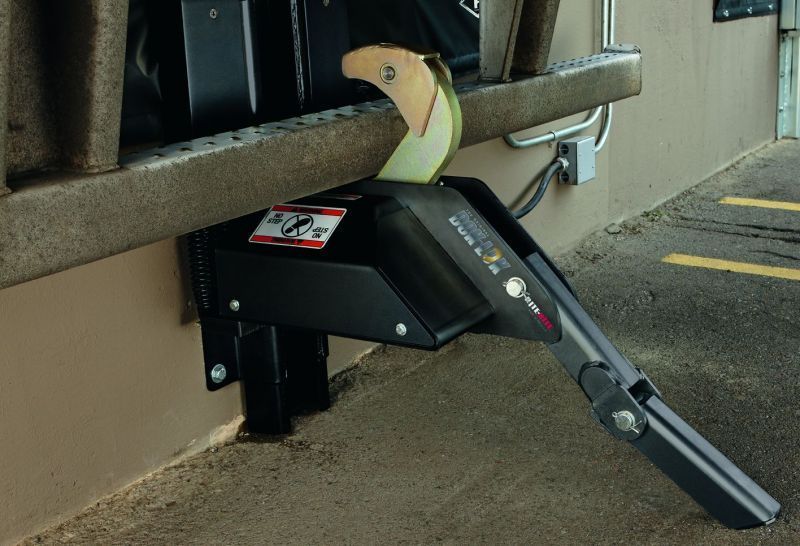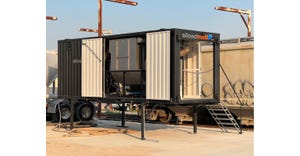July 26, 2017

The loading dock is an essential part of any dry processing or bulk solid handling operation. While busy loading docks are a sign of a healthy business, the constant interaction between trucks, forklifts, and employees presents a high potential for accidents. Additionally, repeated opening of dock doors can waste energy and threaten cargo security. To address these challenges, an increasing number of facilities are upgrading their loading dock areas – and streamlining their operations in the process.
Contamination Concerns
Open dock doors provide an entry point for a host of unwanted intruders like dust, debris, rain, and insects. However, many dock stations provide passageways for these contaminants even when trucks are secured to them and ready for loading and unloading. When traditional trailers are docked and their swing-open doors are opened, 1- to 2-in. gaps often exist between the trailer and the edges of the dock opening. While that might seem insignificant at first glance, it equates to a 2.5-sq-ft hole at just one dock opening – something no facility would want. Multiply that by the total number of dock positions and the significance of the problem becomes clear. Temperature and humidity control are also compromised by these gaps, which can lead to tainted or damaged goods.
Early opening of the trailer is another concern. When the security seal on trailer doors is broken outside the building and the doors are opened in the drive approach by someone other than facility employees, companies have no way of knowing if the contents have been tampered with. This all-too-common occurrence creates a host of potential security issues, which are especially important in the dry processing and bulk solids handling industry.
Energy Losses
From an energy standpoint, these gaps around trailers translate into thousands of dollars of conditioned air flying out the door. That 2.5-sq-ft hole equivalent can represent anywhere from $600 to $1200 worth of lost energy every year. Multiply this over multiple dock doors and the financial loss is significantly more profound.
But the sides of the dock opening aren’t the only gaps in the building’s perimeter. Many facility managers forget about the “fourth side” of the dock – the bottom end, where the leveler, trailer, and dock seal or shelter all meet. Depending on the size of the opening, that gap can result in another $200 to $900 of energy waste annually.
Perimeter Power
One of the best ways to keep contaminants out – and conditioned air in – is to address the perimeter of the dock door. A loading dock seal or shelter creates an environmental barrier between the back end of the semi-trailer and the perimeter of the dock opening. Seals and shelters help keep wind, rain, snow, dust, bugs, and other contaminants outside the building.
An effective dock-sealing system also helps prevent weather-related product damage and contamination, protecting and securing the integrity of products as they move in and out of a facility during manufacturing, processing, and shipping.
Make it a Drive-Through
Increasingly, industrial facility managers are coming to see “drive-through” dock configurations as the gold standard for supply chain security and environmental control. Designed with a recessed pit and vertical-storing levelers, drive-through applications allow trailer doors (and security seals) to be opened inside the loading dock, thus reducing any exposure to the outside environment. In addition, drive-through docks are better from a safety and efficiency standpoint, since neither the driver nor the dock employees need to go outside and open the back of the trailer before it fully backs in and is secured to the dock wall.
Vertical levelers also have maintenance advantages. Unlike pit-style levelers, vertical levelers store up and out of the way, making them easier to clean and wash down the floor. Moreover, vertical levelers (when in the stored position) allow the dock door to close directly onto the pit floor for a tight seal.
Recently, dock shelters have been developed specifically for drive-through applications with vertical levelers. Thanks to special design features, these shelters ensure tight sealing against trailer sides, across the full width of the trailer top and at the corners, without interfering with trailer doors being opened and closed after the trailer has been parked and secured at the dock. When paired with the appropriate under-leveler dock seal, a superior four-sided closure is created around the entire dock opening.
Automating Dock Efficiency
Operational efficiency and employee safety can also be enhanced through automated dock control systems. Traditionally, the various pieces of loading dock equipment (including vehicle restraints, levelers, and overhead doors) were operated independently of each other – with sometimes disastrous results. However, with today’s dock control systems, facilities can ensure the equipment on their dock can only be engaged through a safe sequence of operation.
For instance, the most advanced systems can be programmed with a green light interlock, which disables the use of the hydraulic leveler or overhead door until the vehicle restraint is safely engaged; an overhead door interlock, which requires overhead doors to be opened prior to leveler operation; or a stored leveler interlock, which ensures that the leveler is stored safely before the restraint can release the trailer. If a worker presses the control box button for an individual system element in the wrong sequence, it won’t work. This control box helps ensure that no safety procedures will be skipped.
In all scenarios, the first step is engagement of the vehicle restraint (dock lock) – another piece of equipment that has evolved significantly in recent years. The biggest changes have come in response to the increased prevalence of intermodal cargo and a growing diversity of trailer configurations. Rotating hook-type restraints, which use a rotating hook to secure a trailer by its rear impact guard (RIG), have become ubiquitous at American loading docks. However, intermodal containers are often transported on specialized chassis that have an obstructed RIG, making it nearly impossible for the locking mechanism to fully engage with them. Fortunately, the newest restraints incorporate “shadow” hook technology, which provides an additional pivot point capable of securing trailer chassis with obstructed RIGs. These automatically activated restraints can also be integrated into building management or security systems and will “re-fire” if there is tampering or the trailer attempts to pull away when in the locked position.
Protecting the Supply Chain at the Loading Dock
While no two shipping and receiving operations are exactly the same, a systematic drive-through application at the loading dock will almost always result in significantly enhanced safety, security, and efficiency. These systems combine state-of-the-art elements – such as vertical dock levelers, appropriate seals/shelters, and automatic vehicle restraints – to enhance the integrity of the overall supply chain, help protect employees, reduce contamination, and reduce energy waste.
The information in this article is provided as a general reference regarding the use of the applicable products in a specific application. This information is provided without warranty. It is your responsibility to ensure that you are using all mentioned products properly in your specific application and in accordance with all laws and regulations.
Walt Swietlik is director of customer relations and sales support for Rite-Hite, a world leader in the manufacture and sale of loading dock equipment, industrial doors, safety barriers, and HVLS industrial fans. For more information, visit ritehite.com.
For related articles, news, and equipment reviews, visit our Material Handling & Transportation Equipment Zone
Click here for a List of Material Handling & Transportation Equipment Manufacturers
You May Also Like


